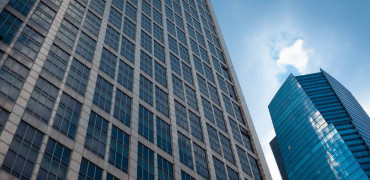As a nation, we are the first in the world to sign up to legally binding targets on carbon reduction, which look to cut emissions by 78% by 2035, compared to 1990 levels.
A major part of achieving this ambitious target is to install 600,000 heat pumps a year by 2028 and this will require a tenfold increase in the number of installations over the next five years.
Many of those heat pump installations will take place in commercial premises and one of the challenges for the businesses running those buildings, is the potential cost and disruption of improving the thermal properties of the building, so that they can benefit best from the inclusion of a heat pump.
That’s where a new document I’ve just been working looks to help, by describing how to design a system that can start off with high temperature flow rates but include the ability to reduce those flow temperatures in the future, once thermal improvements have been made.
We saw a need for such a document looking at a cascade heat pump system because it is not always possible to reduce the heating requirements in a building (certainly not immediately).
Crucially, it can often be difficult, disruptive and costly to upgrade your heating system infrastructure (radiators, fan coils, pipework, AHU etc. etc.) and it is the heating infrastructure that often dictates what temperature the heating system needs to operate at.
If you can’t reduce the load and can’t change the infrastructure, high temperature (i.e. above 70deg) may be your only option.
If this is the case, but you still want to decarbonise and move away using from fossil fuels on site, there are still heat pump options open to you but, as with any solution, these also present challenges and compromises (such as reduced efficiency for high temperature output)
Separating high temperature circuits and allowing other circuits to operate at lower flow temperatures will significantly increase system efficiency
High temperature, low temperature
The document seeks to increasing understanding of the advantages of a ‘cascade’ design concept and the potential benefits of that concept when utilising an air source heat pump (ASHP), combined with a water source heat pump (WSHP).
This cascade-style arrangement can meet the higher temperature requirements of an existing project or application today, whilst also offering the ability to reduce flow temperatures in future once building improvements have been made.
Initially, the design involves the use of heat pump technology to provide heating and/or hot water at high temperatures over 70 degrees Centigrade.
Once thermal improvements to the building have been undertaken, a reduction in flow temperature could be achieved by reducing the WSHP output temperature (therefore improving efficiency) or completely removing the WSHP – allowing the ASHP to satisfy all the requirements at a reduced flow temperature of under 55 degrees Centigrade.
Getting it right from the off
High temperatures can be difficult to achieve using heat pumps systems due to many influencing factors such as:
- The heat pump energy source ‐ Air or Water source heat pump
- The refrigerant utilised within the heat pump – Temperature operating range as well as the Global Warming Potential of the refrigerant used
- Minimum efficiency requirements – Operating costs and operational carbon emissions
- Required capacity of system – Different compressor types for different capacities
By utilising an ASHP to absorb the abundance of low‐grade energy available in the ambient air to produce low temperature water (approx. 25‐55 degrees Centigrade) and then using this low temperature water as the energy source for a WSHP, much higher flow temperatures can be achieved (typically +75 degrees Centigrade).
Unique applications
Whilst every single building and heat pump installation is unique, it is possible to look at the main factors that need to be considered when proposing this type of solution and provide practical information to aid with the initial decision-making process
Before considering any type of HVAC solution, it is important to first address the underlying requirements of the building in line with the overriding goal of achieving Net Zero greenhouse gas emissions by 2050.
Careful consideration should also be given to the overall impact of any solution in terms of embodied carbon, operational carbon, and energy efficiency.
The baseline requirement for energy to heat, cool and ventilate a building should first be addressed using passive measures.
An intelligent building management system or controls interface should then be used to ensure energy is conserved wherever possible.
Renewable energy should be utilised whenever possible and practical with fossil fuels being displaced by scalable renewable sources.
Energy usage should then be accurately measured and reported.
Be lean, mean and green
This follows a basic methodology that we have advocated for over a decade now of adopting a Lean, Mean, Green approach.
Firstly, be Lean – reduce the need for energy consumption in the first place, remembering that the most environmentally-friendly kW of energy is the one you don’t use.
Secondly, be Mean, by using that energy as efficiently as possible. I’ve already mentioned controls because you will not be getting maximum benefit from your energy efficient HVAC equipment if you aren’t monitoring and controlling it properly.
Thirdly, be Green, by getting your energy from low or near-zero-carbon technologies. Get your energy from a sustainable supplier, install Photovoltaics, and then use heat pumps to maximise the return on that energy.
You should also consider installing heat recovery ventilation to bring fresh air inside the building without letting all the heating out.
The importance of being seen
I’ve been thinking recently that as well as being Lean, Mean and Green, companies also now need to be ‘Seen’.
By that, I mean that it is now increasingly important to be able to clearly demonstrate what you are doing to mitigate your energy use and reduce your carbon footprint.
Businesses need to be seen to be taking action, or to be seen to at least have a credible strategic plan in place.
The key to that of course is planning and central to that is measurement – something that needs to be considered right throughout the life span of a building, whether it’s in the concept stage or while planning is underway for a building being refurbished.
Conclusion
The reason I’ve focused on a system using two separate heat pumps is that in a lot of situations at the moment, high and low temperature circuits are often served by the same heat source meaning that high temperatures are produced all the time when only part of the circuit requires them.
Separating high temperature circuits and allowing other circuits to operate at lower flow temperatures will significantly increase system efficiency and reduce energy consumption.
I can only touch on the general principles in a short article like this, but the overall concepts show that, regardless of your building, it is possible to install a renewable heat pump system now.
Added to this is a clear demonstration that taking time to design the system correctly, can lead to changing use as the thermal properties of a building change, and this can not only increase the overall efficiency of the building but also ensure energy costs are also minimised.
Please get in touch if you would like more details of the Technical Overview document, once it is published, or you would like to discuss the concepts further.
Chris Newman can be reached by email: Chris.Newman@meuk.mee.com.
You can also find out more about our Sustainability Team by following this link.
Chris Newman is Net Zero Carbon Design Team Manager



